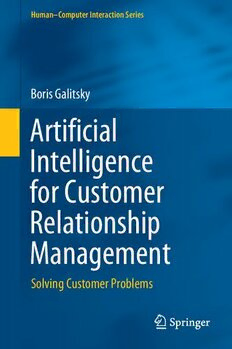Table Of ContentHuman–Computer Interaction Series
Boris Galitsky
Artificial
Intelligence
for Customer
Relationship
Management
Solving Customer Problems
Human–Computer Interaction Series
Editors-in-Chief
DesneyTan
MicrosoftResearch,Redmond,WA,USA
JeanVanderdonckt
LouvainSchoolofManagement,UniversitécatholiquedeLouvain,
Louvain-La-Neuve,Belgium
The Human–Computer Interaction Series, launched in 2004, publishes books that
advancethescienceandtechnologyofdevelopingsystemswhichareeffectiveand
satisfying for people in a wide variety of contexts. Titles focus on theoretical
perspectives (such as formal approaches drawn from a variety of behavioural
sciences), practical approaches (such as techniques for effectively integrating user
needsinsystemdevelopment),andsocialissues(suchasthedeterminantsofutility,
usabilityandacceptability).
HCI is a multidisciplinary field and focuses on the human aspects in the
development of computer technology. As technology becomes increasingly more
pervasive the need to take a human-centred approach in the design and
developmentofcomputer-basedsystemsbecomesevermoreimportant.
TitlespublishedwithintheHuman–ComputerInteractionSeriesareincludedin
Thomson Reuters’ Book Citation Index, The DBLP Computer Science
BibliographyandTheHCIBibliography.
Moreinformationaboutthisseriesathttp://www.springer.com/series/6033
Boris Galitsky
Artificial Intelligence
for Customer Relationship
Management
Solving Customer Problems
BorisGalitsky
OracleLabs
RedwoodShores,CA,USA
ISSN1571-5035 ISSN2524-4477 (electronic)
Human–ComputerInteractionSeries
ISBN978-3-030-61640-3 ISBN978-3-030-61641-0 (eBook)
https://doi.org/10.1007/978-3-030-61641-0
©TheEditor(s)(ifapplicable)andTheAuthor(s),underexclusivelicensetoSpringerNature
SwitzerlandAG2021
Thisworkissubjecttocopyright.AllrightsaresolelyandexclusivelylicensedbythePublisher,whether
thewholeorpartofthematerialisconcerned,specificallytherightsoftranslation,reprinting,reuse
ofillustrations,recitation,broadcasting,reproductiononmicrofilmsorinanyotherphysicalway,and
transmissionorinformationstorageandretrieval,electronicadaptation,computersoftware,orbysimilar
ordissimilarmethodologynowknownorhereafterdeveloped.
Theuseofgeneraldescriptivenames,registerednames,trademarks,servicemarks,etc.inthispublication
doesnotimply,evenintheabsenceofaspecificstatement,thatsuchnamesareexemptfromtherelevant
protectivelawsandregulationsandthereforefreeforgeneraluse.
Thepublisher,theauthorsandtheeditorsaresafetoassumethattheadviceandinformationinthisbook
arebelievedtobetrueandaccurateatthedateofpublication.Neitherthepublishernortheauthorsor
theeditorsgiveawarranty,expressedorimplied,withrespecttothematerialcontainedhereinorforany
errorsoromissionsthatmayhavebeenmade.Thepublisherremainsneutralwithregardtojurisdictional
claimsinpublishedmapsandinstitutionalaffiliations.
ThisSpringerimprintispublishedbytheregisteredcompanySpringerNatureSwitzerlandAG
Theregisteredcompanyaddressis:Gewerbestrasse11,6330Cham,Switzerland
Preface to Volume 2
The second volume of the book on Artificial Intelligence for Customer
RelationshipManagementpresentsabroadspectrumofapplicationdomainswitha
focus on solving customer problems. We design a chatbot to specifically address
issues customer experiences, as well as a system that tries to understand the
customer complaint, his mood, and what can be done to resolve an issue with the
productorservice.
In the first volume of the book, we addressed the key issues of modern CRM
systems,whichfrequentlycannothandlethehighvolumeofcallsandchats.Themain
limitationsofCRMtodayisalackofmachineunderstandingofwhatacustomeris
tryingtosay,whataretheissuesheistryingtocommunicateorattemptstoconceal.To
attacktheselimitations,weproposedanumberofNaturalLanguageUnderstanding
(NLU)techniqueswiththefocusondeeplanguageanalysisandreasoning.
Nothingrepelscustomersasmuchasirrelevant,annoying,intrusiveanswersand
low-qualitycontent.Theinabilitytofindinformationusersneedisamajorreason
theyareunsatisfiedwithaproducerofaprovider.Inthefirstvolume,wesharedthe
evaluationsofquestion-answeringcomponents,verifiedtheirexplainabilityfeatures
and observed a satisfactory lab performance for major CRM tasks. We concluded
that keeping the customers informed is key to their acquisition and retention. For
example,inFig.1,fastaccesstoinformationonwhoownsthebirdiscriticalfora
smoothtransaction.
Inthissecondvolume,wemakethenextsteptotheheartofthecustomerretention
issue: solving a customer problem. Now just understanding what the customer is
sayingisnotenoughanymore:weneedtoinvolveaformalizedknowledgeabouta
productandreasonaboutit.Tosolveacustomerproblemefficientlyandeffectively,
wefocusondialoguemanagement.Adialoguewiththecustomerismaintainedin
such a way so that the problem can be clarified and multiple ways to fix it can be
sought.
IftheCRMisnotintelligentenough,itisnotveryusable.Inparticular,CRMsare
usedbypeoplewhosell,andassuch,theyareoftentravelingtocustomersites,away
fromtheirdesk,infrontofclients,andarepaidtogeneratessales,socommunication
withaCRMisoftenanafterthought.Salespeoplearenothiredfortheircomputeror
dataentryskillsbutinsteadfortheirabilitytosell.Iftheycloseasignificantdealand
v
vi PrefacetoVolume2
Fig.1 Communicating
specificfeaturesofproducts
withabuyer
Fig.2 CharlesFillmore’s
exampleforjointsentence
discourse
neverentereditintotheCRM,somethingmaybesaidafterthecongratulationsonthe
sale,butnoonewouldcomplainaboutnotusingtheCRM.Thegeneralconsensus
amongsalesrepresentativesissimple:noonelikesdumbCRM.Theyarefrequently
overly-complex,clunkysystemswithoutaconversationalinterfacethatdonothelp
themsellandevenobstructthesalesprocess.Sothepersonnelmayuseunintelligent
CRMaslittleaspossible.Morethanathirdofbusinessesfacelowadoptionratesof
CRMsystems.
Ourdialoguemanagementisbasedondiscourseanalysis,asystematiclinguistic
waytohandlethethoughtprocessofanauthor.Discourseanalysisisamethodfor
studying the natural language in relation to its social context. Discourse analysis
trackshowlanguageisusedinreal-lifesituations.Awell-knownAmericanlinguist
CharlesFillmoredemonstratesthattwosentencestakentogetherasasinglediscourse
canhavemeaningsdifferentfromeachonetakenseparately(Fig.2).
The objects of discourse analysis (texts, conversations, communicative events)
are defined in terms of coherent sequences of sentences, propositions and speech
acts.Sometimesdiscourseanalysisevenhelpstogetaconsumeroutoftroubleby
makingaconversationconvincing(Fig.3).Adialoguestructurecantakeapeculiar
formforaconversationbetweentwoapplemaggots(Fig.4).
PrefacetoVolume2 vii
Fig.3 Findinga
contradictionincustomer’s
requestandcommunicating
it
Fig.4 Aconversational
structureoftwoapple
maggots
Wedemonstratehowadialoguestructurecanbebuiltfromaninitialutterance.We
alsointroducerealandimaginarydiscoursetreesasameanstorepresentanexplicit
and implicitdiscourse of text. Aproblem of involving background knowledge on-
demand, answering questions is addressed as well. We outline the Doc2Dialogue
algorithmforconvertingaparagraphoftextintoahypotheticaldialoguebasedonan
analysisofadiscoursetreeforthisparagraph.Thistechniqueallowsforasubstantial
extensionofchatbottrainingdatasetsinanarbitrarydomain.
viii PrefacetoVolume2
Fig.5 Anexampleof
hypocrisy
We compute user sentiments and personal traits to tailor dialogue management
andcontenttoindividualcustomers.Wealsodesignseveraldialoguescenariosfor
CRMwithrepliesfollowingcertainpatternsandproposevirtualandsocialdialogues
forvariousmodalitiesofcommunicationwithacustomer.
To detect fake content, deception and hypocrisy (Fig. 5), we need to analyze
associateddiscoursepatterns,whichturnedouttodifferfromtheonesforgenuine,
honest writing. With discourse analysis, we can zoom in further and characterize
customercomplaintswithrespecttothebestwaytoresolvethem.Wesimulatethe
mentalstates,attitudesandemotionsofacomplainantandtrytopredicthisbehavior.
Having suggested graph-based formal representations of complaint scenarios, we
machine-learnthemtoidentifythebestactionthecustomersupportorganizationcan
choosetoretainthecomplainantasacustomer.
Customer complaints are classified as valid (requiring some kind of
compensation) or invalid (requiring reassuring and calming down) the customer.
Scenarios are represented by directed graphs with labeled vertices (for
communicative actions) and arcs (for temporal and causal relationships between
theseactionsandtheirparameters).Theclassificationofascenarioiscomputedby
comparing a partial matching of its graph with graphs of positive and negative
examples. We illustrate machine learning of graph structures using the Nearest
PrefacetoVolume2 ix
Neighbor approach as well as concept learning, which minimizes the number of
falsenegativesandtakesadvantageofamoreaccuratewayofmatchingsequences
ofcommunicativeactions.
RedwoodShores,CA,USA BorisGalitsky

